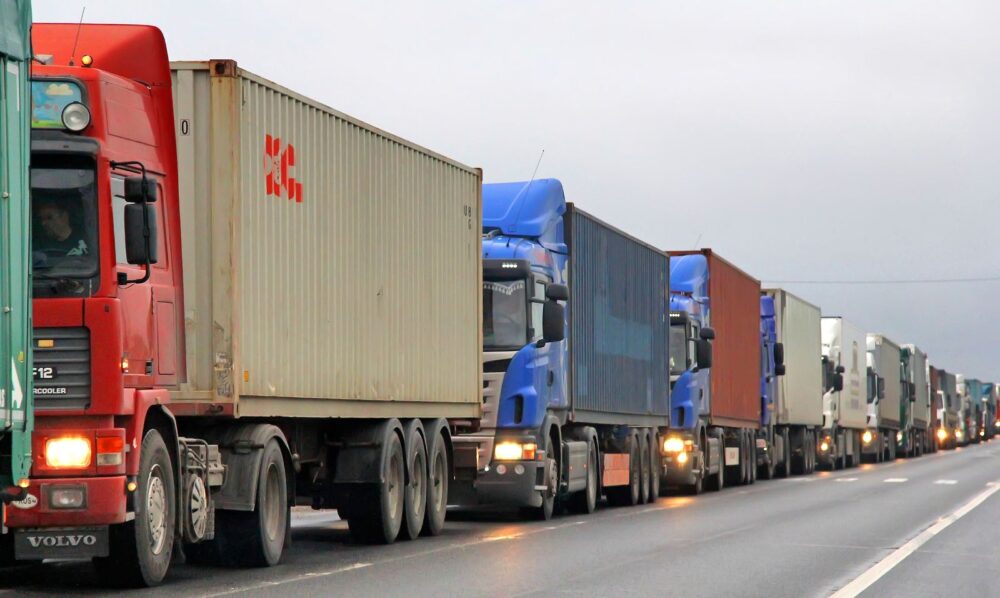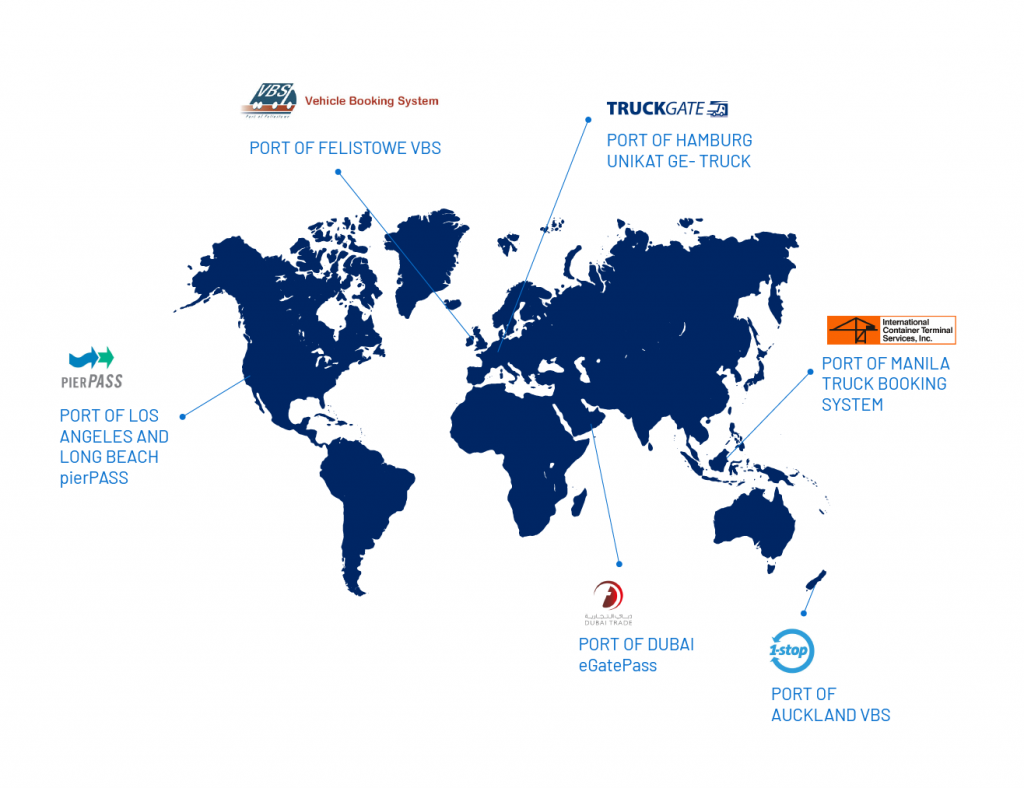 Container terminals can cause traffic congestions. [Image: Art Konovalov / Shutterstock.com]
Container terminals can cause traffic congestions. [Image: Art Konovalov / Shutterstock.com]
Why Do Ports Insist On Implementing Gate Appointment Systems?
Lorry traffic outside the entrance to container terminals isn't a new problem, but the increase in international trade and the trend towards bigger and bigger ships does make it worse. With megaships, you get large-volume operations concentrated in peaks of work that put loads of pressure on terminals and land transport. In those cases, could appointment systems be a solution?
 Container terminals can cause traffic congestions. [Image: Art Konovalov / Shutterstock.com]
Container terminals can cause traffic congestions. [Image: Art Konovalov / Shutterstock.com]
The option of having lorries book an appointment at the terminal doesn't seem like a huge innovation, but it could help mitigate the long queues and transform the sector. Some ports have already tried it. Have they achieved their goals? Why don't they always have the results expected? How should a GAS be implemented to ensure it works properly? These are questions any port involved in international container trade has to ask.
What are GAS?
Gate Appointment Systems (GAS) book or assign time slots for delivering each container, giving preferential treatment to lorries that choose to use this system. The goal is to rationalise and plan when lorries arrive in order to solve the problem of queues at terminals, make the logistics chain more efficient and cut negative externalities, like air pollution.
The increase in sea transport and the arrival of megaships make this need even more pressing. G-class containerships from the Orient Overseas Container Line (OOCL), which can transport up to 21,000 TEUs, are the biggest currently in service. But it is now common to find ships on the scale of more than 18,000 TEUs at main European ports and these can generate more than 6,000 moves concentrated in peaks of just a few hours. Faced with volumes of this magnitude, not having a system to plan lorry arrivals means queues are practically inevitable some times of day.
But do booking systems work in ports? The answer is complicated. The factors that can make GAS a success or failure are varied and include the level of commitment from various stakeholders (port authorities, terminals, shippers and carriers, among others), as well as the incentives available for carriers willing to book an appointment.

Some of the ports that have implemented a gate appointment system recently.
Gate Appointment Systems (GAS) book or assign time slots for delivering each container, giving preferential treatment to lorries that choose to use this system.
Most of the time, this system is voluntary; although some ports have required it by law. This is the case in the ports of Los Angeles, Long Beach and Oakland, where California Assembly Bill (AB) 2650 from 2003 established a system of fines for lorries waiting more than 30 minutes. After being implemented in 13 terminals at these ports, a study was conducted to assess its success, but the conclusions weren't very encouraging: the system didn't reduce the queues. The causes seemed to be a lack of consensus among the port stakeholders (the protagonists complained they hadn't been consulted), the inability to force terminals to apply the appointment system, the lack of incentives for carriers to join the model and the lack of lanes set aside for lorries with an appointment.
Success stories
However, the Port of New Orleans and the Georgia Ports Authority are two examples of good practices. Both are using web applications that allow carriers to book appointments and provide information for pre-authorisation upon arrival to the terminal. This system has improved traffic flow, boosted terminal performance and improved the productivity of carriers and terminals. In Georgia, where clients can access the system 24 hours a day to update their container shipping data, unloading time was cut 30% on average, according to a study by Merk (2014).
In 2016, Brazil created a system called PORTOLOG for the Port of Santos. In this case, when the lorry is loaded, it notifies PORTOLOG by mobile and is put in a virtual queue. Every time it passes a checkpoint, the system receives a signal and notifies the terminal of its position. So, when the vehicle finally arrives at the terminal, it doesn't have to wait.
Felixstowe: the value of experience
Felixstowe, the number one container port in Great Britain, was a pioneer in Europe when it introduced its Vehicle Booking System (VBS) in 2006, after an intense negotiation with all parties involved and a testing period with a group of selected carriers. Before that, more than 40% of lorries arriving were concentrated in 6-hour time spans, which led to horrible traffic at and around the port while the facilities were underused the rest of the day. Plus, more than 25% of lorries arrived with incorrect information, which led to unnecessary trips (with the resulting financial and environmental cost) and even more traffic. With its VBS, the Port of Felixstowe creates a certain number of bookings or slots for each hour of the day, and notifies carriers between 6 and 3 days in advance. If necessary, the port can limit appointments in certain time slots to regulate traffic flow. To deliver or pick up containers, all carriers must have a VBS account, which they use to select a port arrival time. The account is free, as are most bookings. As a result, the Felixstowe VBS has helped reduce traffic at the port and on neighbouring roads, established a direct line of communication with carriers, reduced the number of mistaken or 'empty' trips (without a container) and maximised the port's capacity to accept lorries in the most desirable time slots. A series of recommendations for implementing a booking system stem from this success story. The first is to consult with all parties involved (carriers, shipping lines, terminals, shippers, etc.). Secondly, the booking system must be obligatory to work effectively. Nevertheless, it should be implemented in phases: introduce the concept, explain the benefits, establish a period for registering and start with flexible parameters. Once all parties are familiar with the system, the port should limit booking availability in critical time slots to make the model even more beneficial. For example, in 2014, the Port of Felixstowe started charging for bookings at peak hours.![The mega-ships, capable of transporting thousands of containers, aggravate congestion in the terminal. [Image of Julius Silver]](https://piernext.portdebarcelona.cat/wp-content/uploads/2018/06/piernext_GAS.jpeg)
The mega-ships, capable of transporting thousands of containers, aggravate congestion in the terminal. [Image of Julius Silver]
The Port of Hamburg has also implemented a similar system and, since 2017, carriers must book an appointment ahead of time. Lorry arrivals and terminal capacity are synchronised using a booking process. Drivers register on an app and, when it receives their request, they are given an appointment. The request is processed depending on the priority level and the carrier can drive directly to the loading station, making it more efficient.
For its part, the Barcelona Port Community is starting to work with a booking system now, which will be implemented in phases starting in the coming months.
Advantages of implementing a gate appointment system in the terminal
The experience of pioneering ports in this area (see map) is key to designing a booking model that is guaranteed to succeed and can help overcome well-established dynamics in land transport.
What seems clear is that adopting a good GAS has advantages for the port, in terms of efficiency, as well as its surroundings. These are the most noteworthy:
- Less wait for lorries and optimisation of vehicles, with the corresponding savings on direct costs for carriers.
- Increased number of moves per vehicle, optimising carriers' fleets.
- Improved mobility, at the port and in its surroundings. It is important to remember that the world's main ports are located near large urban areas.
- Reduced CO2 emissions and sustainable growth. Optimising lorries and limiting queues lowers CO2 emissions, which is key to ensuring sustainable growth of ports.
- Improved competitiveness of land transport, which may find booking systems to be a clear driver of change.
- Increased terminal hours. After booking systems, the next step to ensure maximum efficiency and productivity is to expand terminal hours. Depending on market demand, ports can even consider moving towards a 24/7 model in the future. This is a challenge, however, that must have all players in the chain on board, starting with the import/export companies (shippers).
Given the results, it seems the days of carriers showing up unannounced at the terminal are coming to an end. The ability to plan ahead is the most important factor in the supply chain of the future and the only way to ensure this is by implementing a gate appointment system.



